Top 15 food business ideas to make money

Starting a food business is a great way to earn money doing what you love. The food industry offers diverse opportunities, from small-scale and low-cost ventures to high-effort business ideas, empowering you to start on your own terms.
In this article, we’ll explore 15 food business ideas to help you make money while doing something you love.
15 food business ideas to start today
We chose these ideas for their profitability, demand, and growth potential. Pick the one that fits your skills and interests to kick off your food business journey.
1. Get a food truck
A food truck is a flexible way to start a food business without the high costs of running a restaurant. Moving between locations helps you reach more people and boost sales.
A website makes it easy to share your menu, update your location, and take event bookings. It’s a handy way to keep customers in the loop and grow your following. Check out Kogi BBQ’s website for inspiration.
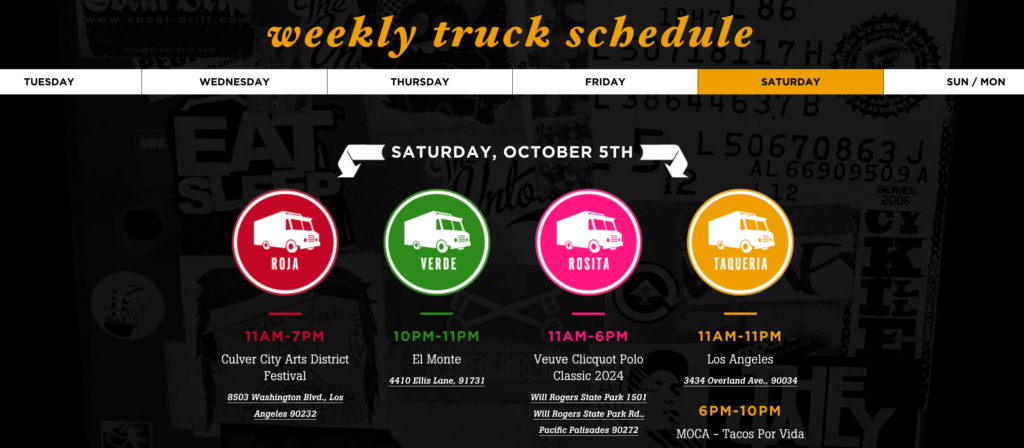
Tips to start
- Purchase a truck. Depending on your needs and budget, consider buying a new or used truck. A used truck can save money, but check its condition to avoid extra maintenance costs.
- Prepare equipment and supplies. This includes a generator, propane tanks, cooking utensils, and food storage containers.
- Get the proper licenses to sell food. Check with your local authorities to understand the health and safety regulations.
- Build your menu. Consider popular food truck items, seasonal options, and specialty dishes.
Benefits
- Mobility. Target busy places like festivals and markets to boost profits and attract more customers.
- Opportunity to experiment. This food business idea enables you to test new menu items in a new location and adjust your menu based on customer feedback.
Considerations
- Ongoing costs. Plan for expenses like truck repairs, fuel, and equipment maintenance.
- Competition for parking spots. Finding the best places can be tricky for a food truck business, especially in busy areas where popular spots are hard to get. Plus, you might need to get permission from the city council or property owner.
- Seasonal fluctuations. Sales may drop during colder months or off-peak seasons, so planning for slower times is essential.
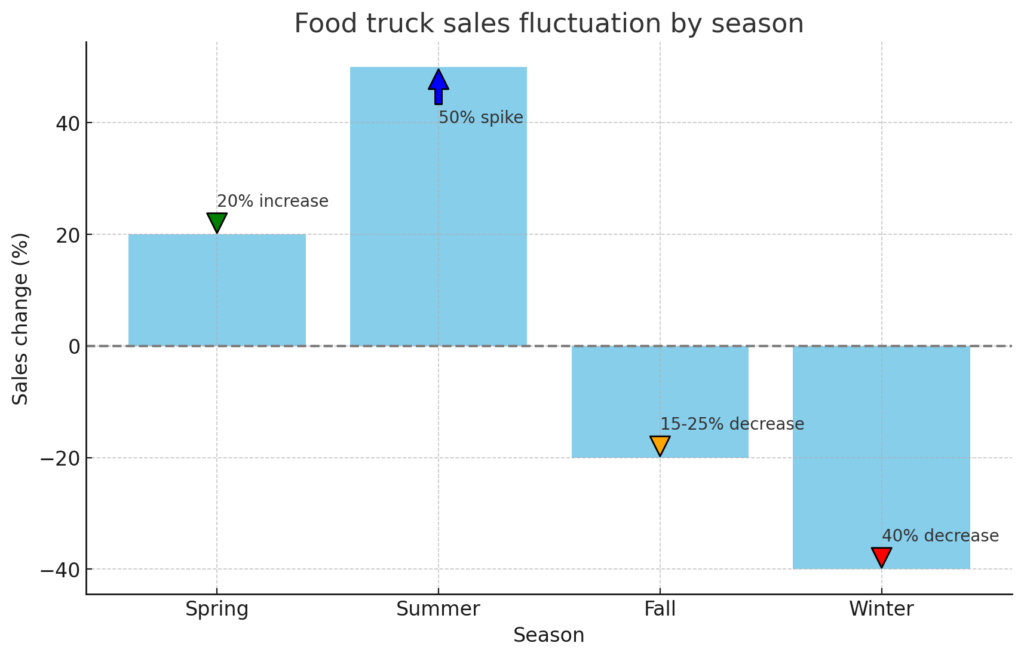
While sales may dip in colder months, use this time to refine your menu or connect with customers online. Embrace the seasonality as a chance to get creative and grow your food truck business steadily.
2. Open a restaurant
Running a restaurant can be challenging, but it’s a rewarding way to turn your love of food into a business. With the right approach, you can create a great dining experience and build a loyal customer base.
Tips to start
- Research and develop your concept. Figure out the type of cuisine to serve, the ambiance of your restaurant, and your target audience.
- Create a solid business plan. Outline your budget, projected income, and marketing strategies. This will be essential when seeking funding from investors or loans from banks.
Download business plan template
- Find the perfect location. Consider factors such as foot traffic, parking availability, and nearby competition. Also, make sure the space meets all necessary health and safety regulations.
- Build a small, reliable team. In the early stages, focus on hiring a few trustworthy people to help you get off the ground. This may include one or two chefs and front-of-house staff. You can grow your team as your restaurant begins to grow.
- Develop an online presence. Build a restaurant website and use social media to attract new customers and keep the current ones engaged. An effective restaurant website can help drive foot traffic and increase visibility. For inspiration, check out the best restaurant website examples.
In your first year, it’s important to stay flexible. Be open to adjusting your menu, trying different marketing strategies, and learning from your customers.
Benefits
- Build a strong, recognizable brand. Establish a unique identity in a permanent location to attract loyal customers.
- Offer a complete dining experience. From the food to the ambiance, you can provide customers with a memorable experience. As a result, you can charge more.
- Grow in the long run. With a solid foundation, you can expand your restaurant over time. This could mean adding new locations or expanding services like catering.
Considerations
- High initial costs. Renting space, buying equipment, and hiring staff can add up. So start with a realistic budget and plan for gradual growth.
- Ongoing maintenance. Managing a physical space involves regular upkeep. This can be costly but is necessary for smooth operations.
- Compliance with regulations. Work with the local health department to ensure your restaurant meets food safety and health standards. This includes regular inspections and adhering to food handling protocols.
- Building a customer base takes time. Marketing and word-of-mouth will help, but patience is key. Focus on delivering great food and service to attract regulars.
Opening a restaurant is no small task, but if you’re passionate about food and experiences, it can be incredibly fulfilling. In your first year, stay flexible – be open to adjusting your menu, experimenting with marketing, and learning from your customers.
3. Launch a coffee shop
Starting a coffee shop business is a great option, with coffee consumption growing globally by 2-2.5% annually. This presents new opportunities to expand sales and build a loyal customer base.
One major appeal of running a coffee shop is its role as a community hub where people can relax, work, or socialize. This helps create lasting customer loyalty and connections.
Tips to start
- Choose a location. Look for a spot with good foot traffic, near offices, universities, or residential areas. Accessibility and parking can also make a big difference in attracting customers.
- Develop your coffee shop concept. Decide on the ambiance, theme, and experience you want to create. Whether it’s a casual hangout spot or a more upscale café, a clear concept will guide your decor and menu decisions.
- Find a reliable coffee bean supplier. Build relationships with local or specialty suppliers to source high-quality beans. This will set the tone for your offers and help define your coffee shop’s unique flavor profile.
- Focus on customer experience. The atmosphere is just as important as the coffee. Provide comfortable seating, free Wi-Fi, and a friendly atmosphere to attract returning customers.
Benefits
- Consistent demand. Coffee and snacks have a steady market, offering dependable daily sales.
- Loyal customer base. You can create a warm, inviting environment that draws in regulars.
- Flexibility to experiment. Offering specialty drinks or pastries helps you stand out and keeps your menu fresh.
Considerations
- Competitive market. Coffee shops are everywhere, so having a unique concept or signature offering is important.
- Profitability. To stay profitable, you’ll need consistent customer traffic, as your average customer might only buy a cup of coffee and stay in your shop for a few hours.
- Health and safety regulations. As with any food business, you’ll need to be aware of food safety laws and regular inspections.
4. Start a bakery
Baked goods have broad appeal and consistent demand, ensuring steady customer interest. Additionally, bakeries offer endless options, from fresh bread to specialty cakes and pastries.
This flexibility makes it easier to scale your business at a comfortable pace. You can start small and grow as demand increases. For example, launching a home-based bakery is a manageable entry into the food industry.
Tips to start
- Choose your specialty. Decide whether to focus on bread, pastries, or cakes. Then, consider targeting niche markets by providing gluten-free, vegan, or organic options. This can help set you apart from other bakeries.
- Start with a home-based bakery. This helps to manage initial costs. Consider expanding to a larger kitchen to accommodate more orders as demand increases.
- Source quality ingredients. Partner with local suppliers to ensure the freshest ingredients. This also helps enhance the quality and flavor of your baked goods. Plus, supporting local businesses can also attract a loyal customer base.
- Invest in equipment. Quality mixers, ovens, and display cases can improve product quality and presentation. To save costs, consider leasing or purchasing second-hand equipment.
Benefits
- Product variety. Bakeries allow you to explore diverse baked goods. From everyday bread to custom cakes, it enables your creativity to shine.
- Niche potential. Gluten-free, vegan, and other specialty baked goods can help you attract health-conscious customers.
- Community engagement. Bakeries can connect with local communities through farmers’ markets or events. This helps build loyal customers and fosters local support.
Considerations
- High costs. Renting commercial baking space and purchasing equipment can be expensive. Remember to plan your budget well.
- Health regulations. Whether cooking at home or in a business, you must follow food safety rules and get the required permits.
Though starting a bakery has its hurdles, the reward is in sharing your passion with the community. Focus on quality, nurture customer connections, and let your love for baking inspire loyal customers.
5. Create a cookie business
A cookie business is accessible to start with low upfront costs. You can run it from home and reach customers with a website.
As your business grows, offer custom cookies for events like weddings and holidays and charge premium prices. Personalized designs also help build strong customer loyalty and encourage repeat orders.
Tips to start
- Choose your niche. Decide between classic, gourmet flavors, or decorated cookies for special occasions. Offering custom designs for events like weddings, birthdays, or holidays can help attract a broader audience.
- Start small. You can begin from your home kitchen, selling locally through your website or social media platforms. If you need any help, follow our tutorial on how to sell cookies online.
- Perfect your designs. Invest time in perfecting your cookie designs. Custom cookies for events are typically sold at higher prices.
- Develop seasonal cookies. Create limited-edition cookies for holidays and special occasions, like Gideon’s Bakehouse. Seasonal products help create excitement and encourage repeat customers.

Benefits
- Scalable business. Starting small from home allows you to expand as demand increases.
- High profitability. Custom and themed cookies can be priced higher, especially for events and holidays.
Considerations
- Precision and skill required. Decorated cookies need attention to detail and creativity. This can be time-consuming, especially when fulfilling custom orders.
- Marketing and promotion. Social media and word of mouth will be key to attracting custom orders and growing your business.
6. Offer event catering
Catering is a flexible and profitable food business. In fact, this market is expected to grow quickly and reach $124 billion by 2032. Many caterers start with certain cuisines or events and grow through referrals.
Tips to start
- Decide on your catering niche. Will you focus on weddings, corporate events, or private parties? Specializing can help you target the right audience.
- Offer customizable menus. Work with clients to create tailored menus that suit their dietary needs and preferences. This will help make your service more appealing and memorable.
- Promote on local events. Begin by catering smaller, local events, such as community gatherings or small weddings. This allows you to build a reputation while managing costs.
- Utilize word-of-mouth. Encourage satisfied clients to spread the word. Excellent service and good relationships with event organizers can lead to steady referrals.
Benefits
- Flexibility. Catering opens doors to various events, from intimate gatherings to large corporate functions.
- Customizable offers. You can create custom menus for clients, boosting customer satisfaction and making your service stand out.
Considerations
- Client expectations management. Communicating clearly with clients about menu details, timing, and special requests is essential. This helps ensure smooth event execution without misunderstandings.
- Inventory and waste management. Estimating food quantities correctly reduces waste and ensures there’s enough for everyone. Efficient inventory management can significantly impact your bottom line.
7. Launch a food subscription box service
Subscription-based food boxes have gained immense popularity. They provide customers with easy meal kits and special food items delivered right to their door. This food business model offers steady, recurring revenue through subscriptions.
Tips to start
- Choose your niche. Decide whether to focus on gourmet ingredients, diet-specific meals, or curated snack boxes.
- Set up a subscription model. Recurring subscriptions are the core of this business. Give customers weekly, bi-weekly, or monthly plans for steady income and flexibility.
- Source high-quality products. Whether you work with local or specialty vendors, ensure your products are fresh, high-quality, and fit your niche.
- Promote convenience. Market your service as a way for customers to save time by not having to shop for groceries or plan their meal.
Benefits
- Recurring revenue. Subscription-based models provide consistent cash flow. This helps maintain financial stability and predict growth.
- Customer loyalty. Subscribers are more likely to stay with your service, especially if they find your curated menu valuable.
- Variety of niche markets. You can meet specific customer needs by offering vegan, keto, or gourmet food boxes. This helps you reach specialized markets.
Considerations
- Inventory and supply chain management. Ensure you have dependable suppliers and manage your inventory well to handle regular orders.
- Customer retention. Maintaining long-term customer satisfaction is key. Regularly refresh your products to engage subscribers and prevent churn.
- Marketing costs. Getting new subscribers can mean significant marketing efforts. So you’ll need to budget for promotions, partnerships, and advertising.
8. Start a frozen food service
Selling frozen meals is a profitable food business idea. The market is expected to grow from $310.77 billion in 2024 to $441.11 billion by 2032. With the rising demand for frozen food, this service is perfect for busy people seeking quick meal options.
Tips to start
- Choose your product line. Decide whether to focus on everyday frozen meals, gourmet options, or organic offerings. Catering to a specific niche helps attract loyal customers looking for specialized products.
- Source quality ingredients. Quality is crucial for frozen products. Partner with reliable suppliers to ensure fresh ingredients. This helps guarantee that they freeze well and maintain their taste and texture over time.
- Follow proper freezing techniques. Learn the best freezing methods, like contact or blast freezing, to preserve the flavor and quality of your meals.
Benefits
- Convenient and profitable. Frozen meals are in high demand, offering customers a quick and easy meal solution while generating steady profits.
- Targeted niches. You can target specific groups like families or busy homemakers who need quick and easy meal options.
- Reduced waste. Frozen products last longer, which helps reduce food waste and makes inventory management easier.
Considerations
- Freezing and packaging quality. Use the proper freezing methods and packaging to keep your products tasty.
- Storage and logistics. Managing storage for frozen products and cold-chain logistics can make operations more complex.
- Customer education. Some customers may need guidance on storing, thawing, and preparing frozen products to ensure the best experience.
9. Build a food delivery service
The food delivery business is more popular than ever, especially with apps making ordering easy. This food business is expected to be worth $637.46 billion by 2034.
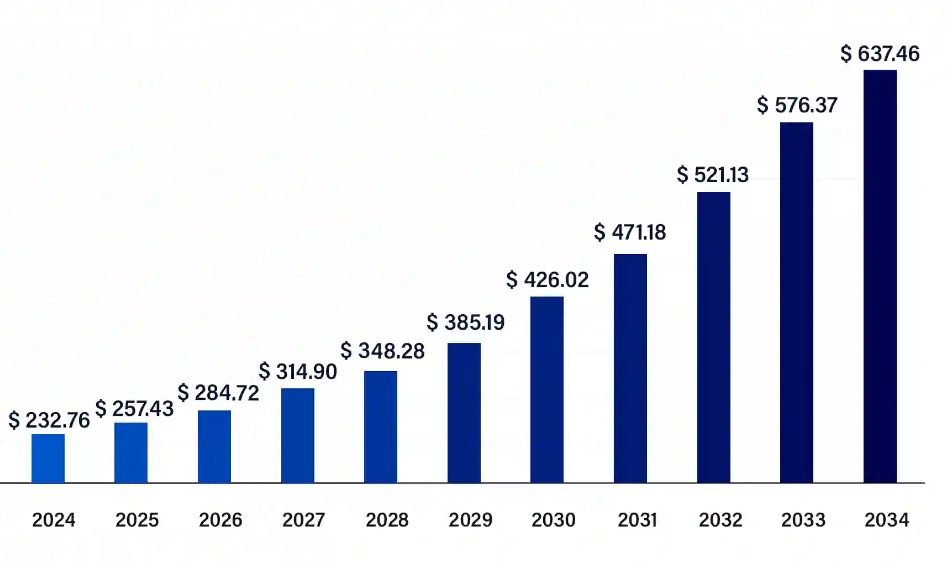
It’s also a flexible business option because people want quick, convenient meals. You can begin from home or use a shared kitchen, which helps keep startup costs low.
Tips to start
- Choose your model. Decide whether to prepare meals from home or rent a cloud kitchen that offer commercial equipment without the costs of running a full restaurant.
- Set up app-based ordering. Partner with platforms like Uber Eats or DoorDash to expand your reach. Consider building a website to engage with customers in the long run.
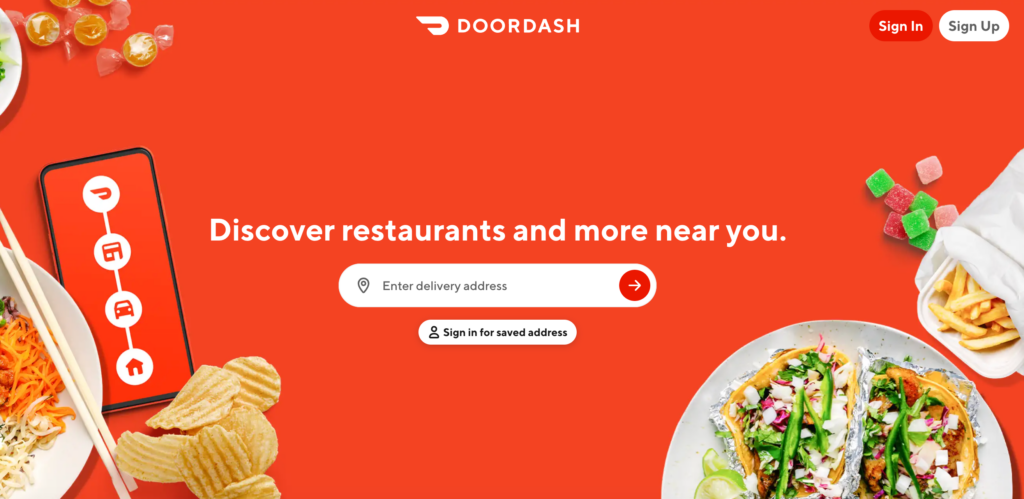
- Invest in delivery logistics. Ensure efficient delivery, whether through third-party services or your team. Reliable packaging and insulated bags are vital in maintaining food quality.
- Offer subscription models. Implement meal subscriptions for regular delivery, offering weekly or monthly meal plans. This provides predictable income and builds customer loyalty.
- Focus on packaging. Use durable, eco-friendly packaging to protect meals during delivery. Clear labeling is essential for dietary-specific meals, like gluten-free or vegan options.
Benefits
- Low startup costs. Home or cloud kitchens reduce overhead, making this model affordable for new entrepreneurs.
- High demand. Delivery services are in constant demand, especially with app-based orders on the rise.
- Recurring revenue potential. Subscriptions and meal kits offer stable, predictable income, enhancing business stability.
Considerations
- Delivery logistics. Managing deliveries requires reliable transport and well-packaged food. This is crucial to ensure food stays fresh during transit.
- Competition. With many delivery services, having a unique menu or fast service helps you stand out.
- Customer expectations. Timeliness and food quality are key to building a loyal customer base.
10. Offer cooking classes
Starting a cooking class business is a fun way to share your love of food while connecting with people eager to learn. Offering personalized experiences, like corporate or one-on-one classes, can really set your business apart by giving students tailored attention and the ability to customize lessons to their preferences.
You can expand your offers with online classes or pre-recorded lessons on your website, which will also allow you to manage bookings and promote your business.
Tips to start
- Choose your format. Consider whether online, in-person, or a mix of both is best for you. Online classes help you reach more people, while in-person sessions provide a hands-on experience.
- Cater to different skill levels. Create classes that appeal to both beginners and more advanced cooks. Offering various levels makes sure everyone gets value, regardless of their experience.
- Offer live and pre-recorded options. Both options give your students more ways to engage with your business.
- Personalize the experience. Private or small-group lessons provide a personal touch that many customers will love. For inspiration, you can learn from Silverado Cooking School and its private classes.
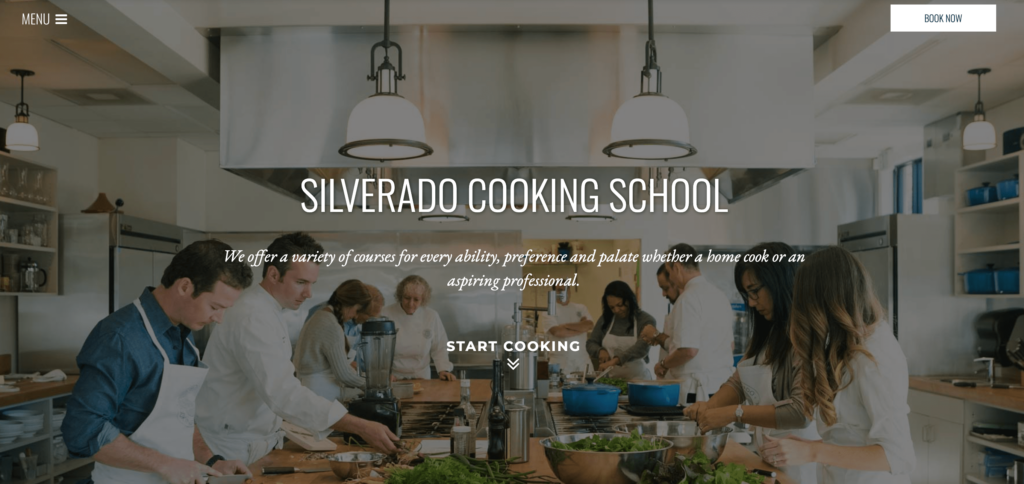
Benefits
- Multiple revenue streams. Offering live sessions and pre-recorded lessons results in reaching a broader audience and more income sources.
- Low startup costs. You can begin from home using minimal equipment, especially for online classes.
- High engagement potential. Personalized lessons or small-group classes offer hands-on experiences, leading to better customer retention.
Considerations
- Technology setup. For online classes, reliable equipment and internet are essential to ensure a seamless experience.
- Standing out. Cooking classes are popular. Something unique, like niche cuisine or personalized attention, will help you stand out.
- Time commitment. Live sessions require more time, while pre-recorded classes can provide a more flexible, ongoing revenue stream.
11. Open a specialty food store
A specialty food store usually sells gourmet foods, spices, and organic ingredients. It connects you with food enthusiasts looking for unique ingredients. These connections can lead to loyal customers, increasing your profit.
Integrating online sales allows you to reach customers beyond your local area. Consider setting up an online store to expand your market and increase your revenue potential. Check out Fine Food Specialist to inspire your online store design.
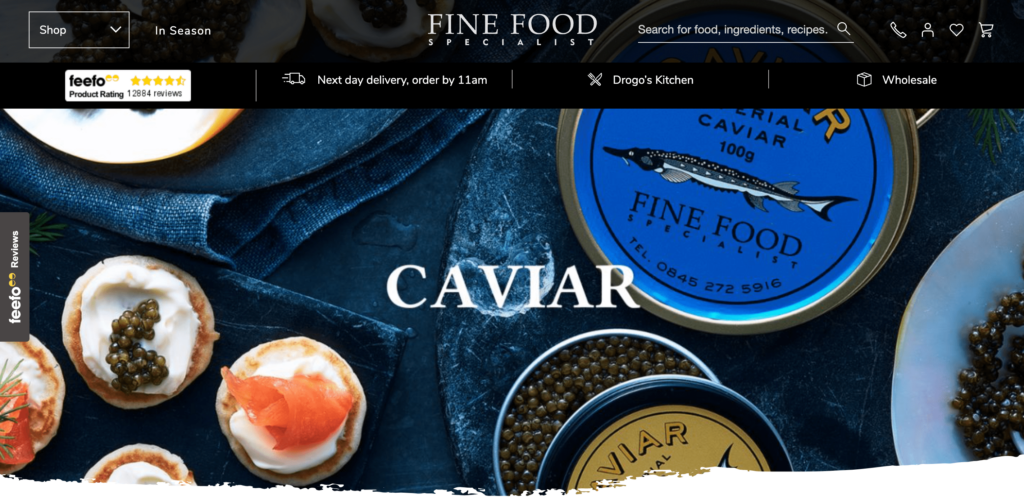
Tips to start
- Pick your niche. Focus on a specific area, like cheese, spices, or organic products, to stand out and attract food enthusiasts.
- Find quality suppliers. Build relationships with suppliers who provide high-quality, unique items to keep customers returning.
- Create an inviting space. Make your physical store visually appealing to encourage repeat purchases.
- Build an online store. An online store can effectively build brand awareness and reach a broader customer base within a smaller niche.
Benefits
- Attracts food enthusiasts. Your unique products help attract customers seeking special items they can’t find anywhere else.
- Niche focus. Specializing in specific products like cheeses or spices sets you apart and builds customer loyalty.
- Broader reach with online sales. Selling online empowers you to serve a larger audience and grow beyond your local market.
Considerations
- Inventory management. Carefully manage stock to avoid overstocking or waste, especially with niche items.
- Supplier relationships. Do business with strong supplier connections for reliable, unique products.
- Online competition. Build strong branding and excellent customer service to stand out online. This will be easier to achieve with a business website.
12. Provide personal chef services
Chefs can increase their earnings by offering personalized services like private dinners and events. Additionally, the demand for personal chefs is growing and is expected to reach $24 billion by 2030.
Catering to special dietary needs, like gluten-free or vegan, can help you stand out in this growing market and boost profits by meeting clients’ tastes and preferences.
Tips to start
- Identify your target market. Focus on clients needing specific dietary preferences, event catering, or weekly meal prep.
- Highlight your services. Emphasize what sets you apart. This could be your dietary expertise, custom menus, or niche cuisines.
- Set clear pricing. Establish your rates based on services like meal prep, private dinners, or events.
- Market through referrals. Satisfied clients are likely to recommend your services. So, focus on delivering exceptional, personalized experiences to build your reputation.
Pro tip
In addition to referrals, consider joining online platforms like Take a Chef to start finding clients.
Benefits
- High earnings. Personal chefs can charge higher prices for their custom services to clients.
- Flexible schedule. Control your work hours and choose how many clients or events to take on.
- Steady income. Offering regular meal prep or subscription services gives you a reliable source of ongoing income.
- Build strong relationships. Personalized services help you build strong connections with clients. This can lead to repeat business and referrals.
Considerations
- Client expectations. High-end services need attention to detail and clear communication to be successful.
- Last-minute changes. You may need to adjust your schedule for urgent client requests or events.
- Quality ingredients. Ensuring consistent quality depends on fresh, high-grade ingredients for each client’s meals.
Meeting client expectations can be demanding, but the reward is building strong client relationships. So take the opportunity to tailor each meal and grow your reputation as a personal chef.
13. Start a food stall or kiosk
A food stall or kiosk is a low-cost way to enter the food business. With minimal setup costs, it offers flexibility and lets you start small. Stalls are great for testing menu items or concepts before expanding into larger food business operations.
The success of a food stall depends on its location and understanding of local tastes. High-traffic spots like markets or festivals can boost sales. Plus, offering unique, appealing dishes helps you stand out.
Tips to start
- Find the right location. Focus on high-traffic areas such as markets, festivals, or near offices. Visibility and accessibility are key to attracting foot traffic.
- Test your menu. A food stall is perfect for experimenting with new dishes or concepts. You can gauge customer feedback before deciding to expand into a larger business.
- Keep it simple. Focus on a few essential items that are easy to prepare and serve quickly. Simplicity helps reduce wait times and keeps operations manageable.
- Prioritize hygiene and presentation. Maintaining high food safety standards is crucial to gaining customer trust, even in a stall.
Benefits
- Lower startup costs. Starting with a food stall needs less investment than opening a restaurant or food truck.
- Flexibility. You can move to new locations depending on customer flow and market opportunities.
- Scalability. Food stalls provide a testing ground for new concepts. This allows you to refine your menu before expanding.
Considerations
- Location matters. Success depends on choosing a high-traffic spot where your target customers frequent.
- Limited space. Operating from a stall restricts space for prep and storage, so you need careful planning.
14. Create a pop-up food experience
A pop-up food experience allows you to test your concepts with minimal commitment. With lower startup costs than a traditional restaurant, this food business allows you to experiment. Think of a public rooftop, an exclusive one-night event, or a themed dining experience.
Simply put, a kiosk is about a convenient location, while a pop-up focuses on the dining experience. The success of a pop-up relies on generating excitement and buzz. Limited-time availability and unique concepts can attract food enthusiasts and build brand awareness, helping you gain a following.
Tips to start
- Choose a temporary location. Explore spaces like cafes or outdoor venues. Temporary setups give you freedom in theme and style.
- Test your concept. Pop-ups are a great way to experiment with menu ideas and gauge customer interest.
- Promote the event. Use social media and partnerships to create urgency and attract customers.
- Keep it simple. A streamlined menu helps you manage operations and ensure smooth service.
Benefits
- Low startup costs. Pop-ups require less investment than permanent locations, making them ideal for testing ideas.
- Creative freedom. You can experiment with new dishes, themes, and dining styles.
- Build brand buzz. The limited-time nature generates excitement, attracting curious customers.
Considerations
- Temporary nature. Since pop-ups are short-term, careful planning is essential to make the most of the limited time.
- Marketing effort. Building excitement and attracting customers relies on strong promotional efforts.
- Location challenges. Securing the right temporary location can be competitive, and logistical challenges like space and setup need attention.
15. Start a healthy meal prep service
A meal prep service offers pre-portioned, already-cooked meals tailored to customer preferences. It caters to busy individuals and health-conscious customers who want convenience without compromising quality.
Success in meal prep services depends on offering personalized meal plans and ensuring consistent quality. Customers appreciate healthy, easy-to-cook meals; recurring subscriptions can help secure steady revenue.
Eat Clean is an example of a healthy food business. It offers customizable meal plans and focuses on using fresh, locally sourced ingredients.
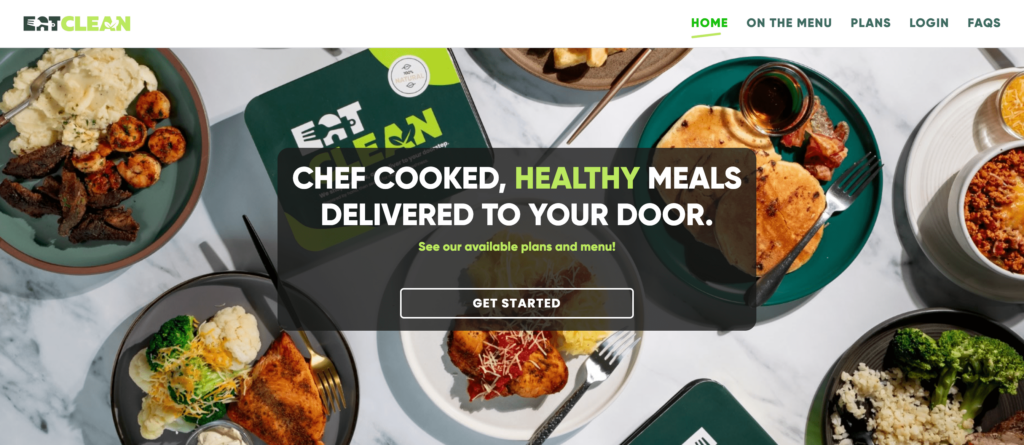
Like Eat Clean, create your own website to help manage subscriptions, showcase meal plans, and share tips. This makes it easier to attract new customers and keep them engaged.
Tips to start
- Choose your target market. Cater to busy professionals, fitness enthusiasts, or those with dietary needs.
- Offer flexible plans. Provide weekly or monthly meal prep options to encourage repeat customers.
- Focus on convenience. Ensure your meals are easy to prepare, and offer doorstep delivery for added value.
- Online presence. Starting a food blog can support your business by sharing meal plans, recipes, and healthy eating tips. It helps position you as an expert and drives traffic to your site.
Benefits
- Lower startup costs. Starting from home reduces overhead, making it a cost-effective way to enter the food industry.
- Recurring revenue. Subscription-based meal plans ensure a steady income from loyal clients.
- Scalability. You can expand your offerings as demand grows, adding more meal options or catering to specific dietary needs.
Considerations
- Menu variety. Offering diverse meal plans is essential to keep customers engaged and returning.
- Logistics. Efficient meal preparation, packaging, and delivery are crucial for satisfying your clients.
- Time management. Preparing multiple meals at once requires careful planning to ensure quality and freshness.
Despite these considerations, starting a healthy meal prep business lets you deliver quality meals while building trust through personalized plans. As demand grows, staying flexible will help your business thrive.
Conclusion
These 15 food business ideas offer aspiring entrepreneurs a range of opportunities, from flexible, low-cost startups like food trucks and pop-up restaurants to more personalized ventures like meal prep services and catering.
No matter which path you choose, these ideas have common vital elements:
- Customization. Most ideas allow menu or service customization, appealing to specific customer preferences.
- Low initial investment. Many of these businesses, such as food stalls or meal prep services, have low startup costs, making them accessible for first-time business owners.
- Scalability. These businesses can start small and grow, allowing owners to expand when ready.
- Customer demand. Whether it’s convenience-driven demand for delivery or niche products, these ideas respond to real market needs.
- Online presence. A professional website and social media help showcase your business, attract customers, and boost visibility.
With lower barriers to entry, now is the perfect time to turn your love for food into a profitable business. Start your food business today!
Food business ideas FAQ
Which food business is most profitable?
Catering and food trucks are among the most profitable food business ideas due to low overhead and high demand. Specialty food products like organic or gourmet foods can also be very lucrative, especially with the right marketing and niche.
What is the best food business to start?
The best food business depends on your skills, budget, and goals. Food trucks and meal prep services offer flexibility, while bakeries and coffee shops provide stability. Choose a model that fits your strengths and market demand.
What food can I sell to make money?
Popular options include baked goods, healthy snacks, gourmet meals, and meal prep services. You can also sell niche items like vegan, gluten-free, or organic foods, which have growing demand and cater to specific audiences.




